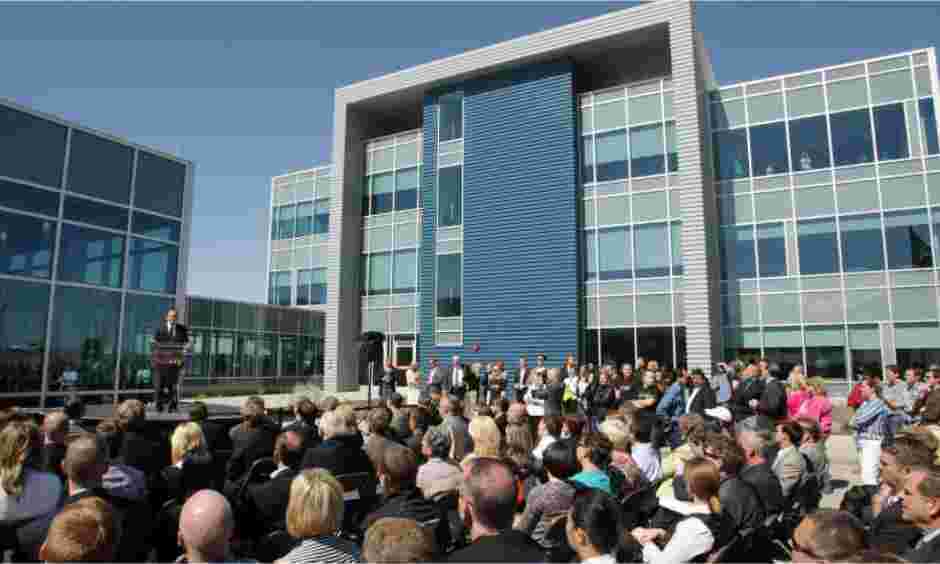F.C. Tucker Commercial Thursday presented its annual State of Real Estate program, a panel discussion about recent trends and predictions in the region’s residential, retail and industrial real estate markets. F.C. Tucker officials and Evansville Mayor Lloyd Winnecke participated. A few of the highlights:
Officials said 2017 saw significant activity in local industrial real estate, and the plastics industry was a major driver. Two former Whirlpool warehouses on St. George Road were bought last year for distribution of plastics, and a $2.1 million sale last May on St. Joseph Industrial Park Drive is facilitating a plastics company expansion.
An empty building in the Vander burgh Industrial Park drew an Israeli-owned company in the plastics industry. “The economic impact of the plastics industry is huge, and as the economy stays strong, I look for the industrial demand to stay strong as well,” said Ken Newcomb, president of F.C. Tucker Commercial.
New comb also noted another recent industrial development win for the region, a TaylorMade golf equipment distribution center at 4400 Garrison Drive.
There tail market has been busy as well, although the continued trend to online shopping has caused some hits, such as the pending loss of Evansville’s Sears store in Washington Square.
Fresh Thyme has opened at The Promenade, and Dick’s Sporting Goods just opened its new store in the former Gordman’s store at East Lloyd Commons, relocating from the Pavilion shopping center further east.
Dick’s will have lower rent and an additional 15,000 square feet at the new site, said Aaron Kendall, F.C. Tucker Commercial vice president.
The new year is expected to bring the arrival of Costco at The Promenade, a relocation of Burlington Coat Factory, the arrival of At Home in Burlington’s former space and a few Eastland Mall additions, such as Box Lunch and Carters/Oshkosh B’gosh.
There’s been quite a bit of new office development in the region, but a lot of B or C class space remains vacant in Downtown Evansville and elsewhere.
Energy Systems Group moved into a new building, just east of Interstate 69 in Warrick County. New burgh Family Dental built on Ruffian Lane, and a new medical office facility is going on adjacent to Target Pavilion on Evansville’s East Side.
The former ITT Tech building is now occupied by Approval Payment Solutions. Commerce Bank opened a new branch at Lloyd and Eagles Crest Drive and relocated its corporate headquarters to nearby 320 Eagle Crest Drive.
The high level of vacancy “speaks to the need of those landlords to adapt and change to the new workforce taking over these spaces,” said Kyle Bernhardt, who works in F.C. Tucker Commercial in commercial sales and leasing.
The region’s tallest building, at 420 Main St., is back on the open market. A purchase option and redevelopment plan was announced at the 2017 State of Real Estate event, but it did not materialize.
“Although we are sad to see this potential project put on hold, we are still very excited about how this property could truly transform Downtown,” Bernhardt said.
Locally and nationally, new home construction starts are well below demand, said John Briscoe, vice president of F.C. Tucker’s residential division.
Vanderburgh and Warrick counties saw 535 housing starts in 2017. That number will likely grow about 10 percent in 2018, Briscoe said.
The local residential market saw record low inventory levels in 2017. Briscoe said houses were on the market an average of 56 days, and it was common during the spring and summer to see multiple offers on houses and offers above the asking price.
Winnecke said the region’s economy is strong. He pointed to major publicly supported projects in Downtown Evansville and organic growth elsewhere in the community.
The Multi-Institutional Academic Health Science and Research Center, a Downtown building that will house academic programs from three universities, is more than 70 percent completed and will be open for classes in August. Construction on the campus’ second building could begin this year.
“Strong regions have strong cores in their primary cities, but it’s not just Downtown where that is happening,” Winnecke said. “Literally, there is hundreds of millions of dollars of investment underway in our city right now … I think 2018 will be another banner year for the community. I hope people are documenting how the city is changing for the better.”

